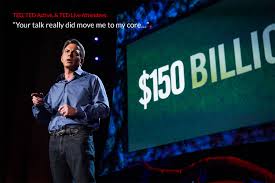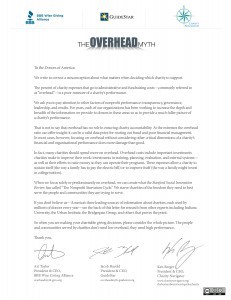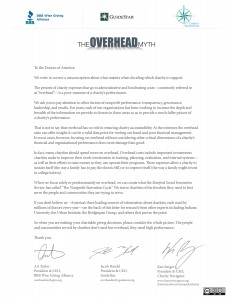Dan Pallotta, Dreams, Overhead and Accounting
By Dani RobbinsRe-published with permission from nonprofit evolution blog
 Have you seen Dan Pallotta’s TED Talk entitled “The Way We Think About Charity is Dead Wrong?” It challenges us to question the way the public thinks about nonprofits and also the way we think of ourselves.
Have you seen Dan Pallotta’s TED Talk entitled “The Way We Think About Charity is Dead Wrong?” It challenges us to question the way the public thinks about nonprofits and also the way we think of ourselves.
He says the right question is to ask “about a nonprofit’s dreams.” The wrong question is to ask about a charity’s overhead. Overhead is not the enemy.
Overhead including part of the CEO’s salary, the fundraising & support staff, the facility, utilities and the equipment in the administrative offices supports the provision of programming.
Organizations that have minimal overhead also have minimal capacity. Overhead is a part of growth, and challenging a non-profit’s ability to increase overhead comprises their ability to grow program services.
I’d also add that non-profits, like the rest of the world, get what they pay for.
While many nonprofit leaders are exceptional at getting goods and services pro-bono (read: free), it is hard to find excellent leaders to work for free. Some have the financial luxury to be able to do that – and that is wonderful – but most of us don’t. As such, I love Pallotta’s point about our society not wanting to pay a lot of money for people who are helping other people, but having no problem at all with people making a lot of money not helping people.
The other part of the overhead issue is this: It’s sometimes an accounting choice.
I used to have a Board member who said “There’s cash and there’s accounting.”
If you have a non-profit who books their CEO’s salary across the programs (based on a time study that reflects how much time they actually dedicate to programming) it will look like appreciably less overhead than the one who doesn’t. Even though the first CEO probably makes more than the second.
If you ask the question about overhead and don’t ask any follow up questions, you won’t get the right information. And any question that doesn’t get you the information you seek isn’t the right question.
 Pallotta’s illustration of someone who really cares about hunger yet chooses against becoming a non-profit leader and ‘takes a huge salary working for a for-profit company and then gives $100,000 to a hunger charity, becomes a celebrated philanthropist and Board member of that charity supervising the person who became the CEO, while still making multiples of that CEO’s salary’ is brilliant!
Pallotta’s illustration of someone who really cares about hunger yet chooses against becoming a non-profit leader and ‘takes a huge salary working for a for-profit company and then gives $100,000 to a hunger charity, becomes a celebrated philanthropist and Board member of that charity supervising the person who became the CEO, while still making multiples of that CEO’s salary’ is brilliant!
He goes on to challenge us to “ask about the scale of their dreams; how they measure their progress toward those dreams and the resources they need to make those dreams come true.” Also brilliant!
I once heard someone say that to raise a million dollars you need to have million dollar dreams. The guardian angels who will fund your agency in full, no questions asked, are far and few between. As such, some questions for your consideration:
- Do you have million dollar dreams?
- Does your non-profit have a generous, or even reasonable, compensation package for the staff?
- Can you communicate your organization’s impact?
- Do you challenge the status quo?
For Board members and community leaders: Are your expectations for non-profit staff different than your expectations for your own staff?
Culture change is hard and so is changing the world. Let’s start asking the right questions, getting the right answers and allowing our non-profits to dream. Let’s fund the dreams that improve our communities!
As always, I welcome your experience and insight.



 As they say, the proof is in the pudding which is what inspired today’s blog post. The pudding, of course, is an article that washed into my email inbox from LinkedIn on November 30, 2013. The author was John Wasik and the article was titled “
As they say, the proof is in the pudding which is what inspired today’s blog post. The pudding, of course, is an article that washed into my email inbox from LinkedIn on November 30, 2013. The author was John Wasik and the article was titled “
 AND THEN IT WENT VIRAL . . .
AND THEN IT WENT VIRAL . . .